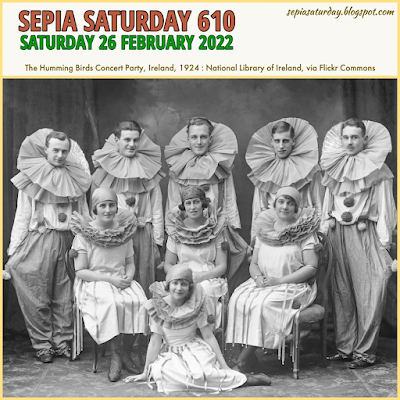After the end of WWI (in November 1918), it seems Gerda (older half-sister to my grandmother Sally) remained in France for nearly another year, with the same employer, in Lyon. According to info I got years ago from a grandson of Gerda's sister Emma), a work certificate dated 28.9.1919, in Lyon, states that she has been working as Lady's Maid, and is an "excellent packer and hairdresser and a neat needlewoman, her French is good".
I don't have the name of Gerda's "lady" in France, but the work certificate, written in English, seems to support my theory that she may have been American rather than French. And if so, maybe she decided for her own part that it was now time for her to go back to the US. For all I know, she may also have wanted Gerda to go with her. But whether Gerda had that option or not, she decided instead to go back to Sweden. (Cf. a comment Gerda wrote on a card to her brother Gustaf in Sweden already back in January 1915: "Maybe I'll come home instead of America.") (G.073.03)
Alas, I don't have any postcards written by Gerda in 1919. But I know that she went back to Sweden, because her next employment was in Stockholm.
I also have this photo...
 |
| Photographer: Emil Svensson, Fristad |
... taken by a photographer in Fristad, Sweden, where the family farm Storegården was situated.
There is no date attached to the photo, though. When I first found it (years ago), I thought it might be from when Gerda returned from America. But that was in 1911, and the fashion here seems too advanced for that year. And if it was from 1911, then who was that woman on the right - holding hands with Gerda? The one on the left looked like Hildur, half-sister to my grandmother Sally, step-sister to Gerda. But in 1911, Sally was only 11 years old, so couldn't be her on the right...
Fast forward to December 1919, though, and it all makes sense. (Even if I still have difficulties quite recognizing Sally in that hat pulled down over her eyes!) Gerda's return from France after the war would no doubt have felt worth celebrating with a visit to a photographer's studio. Perhaps they are even wearing the latest fashion "straight from Paris". I'm thinking Gerda came home for Christmas, bringing gifts. (And she's even likely to actually have visited Paris on her way home.)
Hildur (27), Gerda (38), and Sally (19, soon to turn 20)
(And the fashion fits rather well with 1919/20, I think.)
https://vintagedancer.com/1900s/1919-clothing/


I think you've done some excellent deducing re: the photo and when it was taken. The fashions surely are close to the 1920s. Nice to see Gerda with family again. :)
ReplyDeleteThanks LaN :)
DeleteTerrific photo, that captuers the era. What a dramatic change in faship post-WWI.
ReplyDeleteYes - it seems one good thing that came out of WWI was more practical clothes!
DeleteConsidering the way our world is today it's easy to understand why anyone separated from their family by war would want to return home rather than travel further away. If you are right about Gerda's employer being American, then surely she likely felt the same way too, though at the same time wanting to retain a faithful servant.
ReplyDeleteI play the photo dating puzzle all the time and women's fashions are always a better guide for deciding time period for a photo. In this case their winter coats are less helpful as I think few people changed a warm coat to suit fashion trends, so I'd go with their hats and shoes which look closer to 1920 than 1910. When I need help, I check through vintage newspapers and magazines for department store advertisements with clothing illustrations. They offer good examples of how hemlines, hat styles, and other clothing accessories evolve over time.
Mike, I found images of 'travel' coats from 1918/19 much like the one Hildur (to the left) is wearing. The web page where I found the images I'm thinking of did not allow copying/downloading but can be seen at https://vintagedancer.com/1900s/1919-clothing/ Fur collars seem to have been popular too, as well as hats getting smaller.
DeletePS. Added that link now to the post itself as well.
DeleteI agree - the fashions do look far more post war, with the shorter skirt lengths and the hat style. I have some family photographs c. 1920 in very much the same style.
ReplyDeleteThanks Sue. Just added a link to my post showing some fashion images that I compared the photo to.
DeleteGreat deductions and a lovely photograph. Since they are all dressed in warm coats, was this perhaps taken outdoors, or was this common, I wonder?
ReplyDeleteKathy, it's an indoors studio portrait. (I've even seen other photos from the same photographer with the same background before, online.) I think that rather supports my scenario though: Gerda left her employment in Lyon at the end of September 1919, travelled back to Sweden via Paris, and had a bit of a shopping spree there, buying Christmas gifts, before returning to Sweden to celebrate Christmas with her family. I think they're wearing their coats and hats because it's winter, the clothes are new, and the girls wanted to show them off. Living on a farm in the countryside, Hildur and Sally would not normally be as elegantly dressed up as this.
Delete